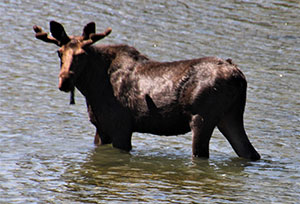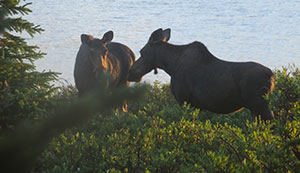Volunteers Spot 16 Animals During UWs Biodiversity Institute Summer Moose Day
Published August 01, 2022

For the seventh year, community scientists helped identify moose populations in the mountains outside of Laramie for Summer Moose Day. And the numbers were comparable to previous summer counts.
Thirty volunteers ventured out in Albany County July 16, covering five routes in the Pole Mountain area, six routes in the Snowy Range and one near Arlington. The University of Wyoming’s Biodiversity Institute sponsored the event.
“Surveyors saw 16 moose: 10 males, five females and one calf,” says Mason Lee, senior project coordinator of the UW Biodiversity Institute. “This number seems about comparable to previous Summer Moose Days, although there is certainly variation between years. On average, throughout the previous years, males are the most commonly observed. Signs of moose -- such as scat and tracks -- also were observed. Because of heavy rains in parts of the survey areas, it was difficult to tell if the scat was fresh or old.”
The 16 moose spotted match the number found in summer 2016.
In a change from previous Moose Days -- where each route was only surveyed by one group -- a few of the routes were covered by more than one survey group.
“This change was requested by the Moose Day researcher, as this will allow for data to be collected to see how good people are at detecting signs of moose,” Lee says.
The community scientists hiked or drove designated routes between dawn and midmorning. They recorded observations of moose or their signs, which include tracks/hoofprints, bed areas, scat droppings and browse on aspen and willows.
These volunteer observations were loaded into iNaturalist so the public can view right away where moose were seen. INaturalist is a joint initiative of the California Academy of Sciences and the National Geographic Society. Postings from the current season can be found at www.inaturalist.org/projects/summer-moose-day.

The data gathered from Summer Moose Day are shared with biologists at UW. These biologists use the data collected by community scientists to further their understanding of the population densities of local moose, their reproductive rates, summer habitat quality, their winter ranges and how these variables change over time.
More will be learned after Dave Christianson, an associate professor in the UW Department of Ecosystem Science and Management, and his graduate students analyze the Summer Moose Day data as well as external factors that can affect moose counts, Lee says.
Both summer and winter Moose Day events are geared toward increasing the public’s understanding of moose in the Laramie area and involving the public in asking and answering questions. These events are an extension of the original program, Moose Day, held by Nature Mapping Jackson Hole (NMJH) in Jackson each winter. NMJH is a citizen science program created by the Jackson Hole Wildlife Foundation.
The UW Biodiversity Institute fosters conservation of biodiversity through scientific discovery, creative dissemination, education and public engagement. In this setting, scientists, citizens, students and educators come together to share a wealth of perspectives on the study and appreciation of biodiversity -- from microbes to poetry and ecosystems to economics. Learn more at www.wyomingbiodiversity.org.

